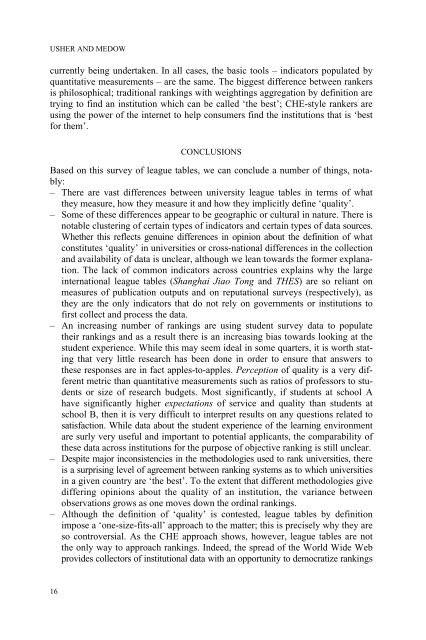University Rankings, Diversity, and the New ... - Sense Publishers
University Rankings, Diversity, and the New ... - Sense Publishers
University Rankings, Diversity, and the New ... - Sense Publishers
Create successful ePaper yourself
Turn your PDF publications into a flip-book with our unique Google optimized e-Paper software.
USHER AND MEDOW<br />
currently being undertaken. In all cases, <strong>the</strong> basic tools – indicators populated by<br />
quantitative measurements – are <strong>the</strong> same. The biggest difference between rankers<br />
is philosophical; traditional rankings with weightings aggregation by definition are<br />
trying to find an institution which can be called ‘<strong>the</strong> best’; CHE-style rankers are<br />
using <strong>the</strong> power of <strong>the</strong> internet to help consumers find <strong>the</strong> institutions that is ‘best<br />
for <strong>the</strong>m’.<br />
CONCLUSIONS<br />
Based on this survey of league tables, we can conclude a number of things, notably:<br />
– There are vast differences between university league tables in terms of what<br />
<strong>the</strong>y measure, how <strong>the</strong>y measure it <strong>and</strong> how <strong>the</strong>y implicitly define ‘quality’.<br />
– Some of <strong>the</strong>se differences appear to be geographic or cultural in nature. There is<br />
notable clustering of certain types of indicators <strong>and</strong> certain types of data sources.<br />
Whe<strong>the</strong>r this reflects genuine differences in opinion about <strong>the</strong> definition of what<br />
constitutes ‘quality’ in universities or cross-national differences in <strong>the</strong> collection<br />
<strong>and</strong> availability of data is unclear, although we lean towards <strong>the</strong> former explanation.<br />
The lack of common indicators across countries explains why <strong>the</strong> large<br />
international league tables (Shanghai Jiao Tong <strong>and</strong> THES) are so reliant on<br />
measures of publication outputs <strong>and</strong> on reputational surveys (respectively), as<br />
<strong>the</strong>y are <strong>the</strong> only indicators that do not rely on governments or institutions to<br />
first collect <strong>and</strong> process <strong>the</strong> data.<br />
– An increasing number of rankings are using student survey data to populate<br />
<strong>the</strong>ir rankings <strong>and</strong> as a result <strong>the</strong>re is an increasing bias towards looking at <strong>the</strong><br />
student experience. While this may seem ideal in some quarters, it is worth stating<br />
that very little research has been done in order to ensure that answers to<br />
<strong>the</strong>se responses are in fact apples-to-apples. Perception of quality is a very different<br />
metric than quantitative measurements such as ratios of professors to students<br />
or size of research budgets. Most significantly, if students at school A<br />
have significantly higher expectations of service <strong>and</strong> quality than students at<br />
school B, <strong>the</strong>n it is very difficult to interpret results on any questions related to<br />
satisfaction. While data about <strong>the</strong> student experience of <strong>the</strong> learning environment<br />
are surly very useful <strong>and</strong> important to potential applicants, <strong>the</strong> comparability of<br />
<strong>the</strong>se data across institutions for <strong>the</strong> purpose of objective ranking is still unclear.<br />
– Despite major inconsistencies in <strong>the</strong> methodologies used to rank universities, <strong>the</strong>re<br />
is a surprising level of agreement between ranking systems as to which universities<br />
in a given country are ‘<strong>the</strong> best’. To <strong>the</strong> extent that different methodologies give<br />
differing opinions about <strong>the</strong> quality of an institution, <strong>the</strong> variance between<br />
observations grows as one moves down <strong>the</strong> ordinal rankings.<br />
– Although <strong>the</strong> definition of ‘quality’ is contested, league tables by definition<br />
impose a ‘one-size-fits-all’ approach to <strong>the</strong> matter; this is precisely why <strong>the</strong>y are<br />
so controversial. As <strong>the</strong> CHE approach shows, however, league tables are not<br />
<strong>the</strong> only way to approach rankings. Indeed, <strong>the</strong> spread of <strong>the</strong> World Wide Web<br />
provides collectors of institutional data with an opportunity to democratize rankings<br />
16














